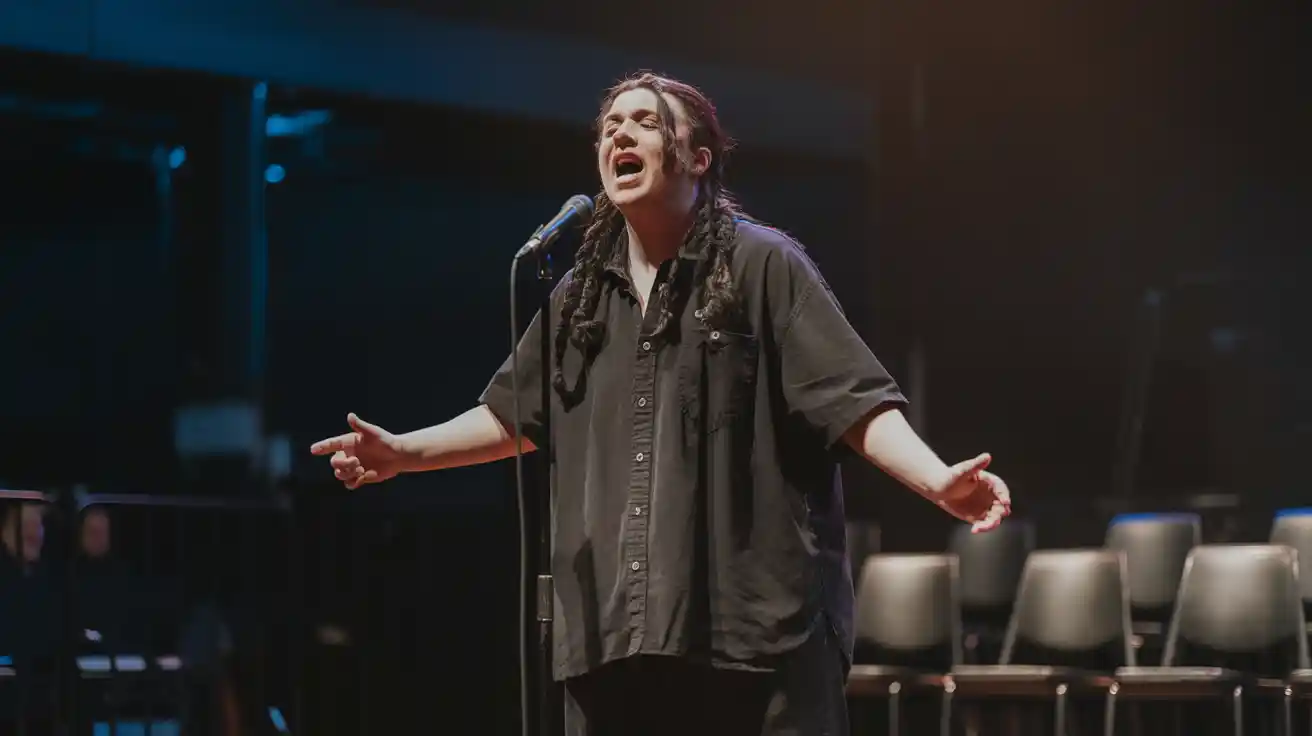
Slam Poetry
Slam poetry is a dynamic art form that blends raw emotion, storytelling, and performance into a captivating spoken word experience. Imagine standing on a stage, your voice echoing through a hushed crowd, as you weave words into powerful narratives. Consequently, this art form empowers poets to express their truths, connect with audiences, and spark change. Whether you’re a seasoned poet or a curious beginner, slam poetry offers a platform to unleash creativity. In this guide, we’ll explore its origins, techniques, and tips to master this craft, ensuring you’re ready to dive into the vibrant slam poetry scene.
What Is Slam Poetry?
Slam poetry is a competitive form of spoken word poetry performed live, often in front of an enthusiastic audience. Unlike traditional poetry, it emphasizes performance, rhythm, and emotional delivery. Poets typically have three minutes to deliver their piece, judged on content and presentation. Therefore, slam poetry combines writing, theater, and storytelling, creating an immersive experience. Its roots lie in the 1980s Chicago poetry scene, where Marc Smith, a poet and construction worker, sought to make poetry accessible. Today, it thrives globally, offering a platform for diverse voices. By blending passion and performance, slam poetry transforms words into a powerful, living art form.
The History of Slam Poetry
The history of slam poetry began in 1984 when Marc Smith organized the first poetry slam at a Chicago jazz club. He aimed to democratize poetry, moving it from academic circles to public spaces. Consequently, slams grew popular, spreading to cities like New York and San Francisco. By the 1990s, the National Poetry Slam emerged, showcasing poets nationwide. Influenced by hip-hop, jazz, and oral traditions, slam poetry became a voice for marginalized communities. Today, global events like the World Poetry Slam amplify diverse narratives. This evolution highlights slam poetry’s role as a cultural force, blending performance poetry with social commentary.
Why Slam Poetry Matters Today
Slam poetry remains relevant because it amplifies authentic voices in an increasingly digital world. It provides a space for poets to address social issues, personal struggles, and cultural identities. For instance, topics like racial justice, mental health, and gender equality often dominate slams. Moreover, its accessibility allows anyone with a story to participate, fostering inclusivity. The raw energy of live performances creates connections that virtual platforms can’t replicate. Additionally, slam poetry inspires activism, encouraging poets to challenge norms through spoken word. As a result, it continues to shape conversations, empower individuals, and build communities, making it a vital art form in today’s society.
Key Elements of Slam Poetry
Emotional Authenticity
Emotional authenticity is the heartbeat of slam poetry. Poets draw from personal experiences, channeling raw feelings into their work. This vulnerability resonates with audiences, creating a shared emotional journey. For example, a poet might explore grief or joy, using vivid imagery to evoke empathy. Consequently, authenticity builds trust, making the performance impactful. To achieve this, poets must dig deep, reflecting on their truths. However, over-dramatization can feel forced, so balance is key. By staying genuine, poets craft pieces that linger in listeners’ minds, ensuring the performance feels real and relatable, a cornerstone of successful spoken word poetry.
Rhythm and Flow
Rhythm and flow define slam poetry’s musicality. Poets use cadence, pauses, and pacing to enhance their delivery. Unlike traditional poetry, slam relies on spoken rhythm, often mimicking hip-hop or jazz. For instance, varying tempo can emphasize key lines, captivating the audience. Additionally, repetition and alliteration create a natural flow, making poems memorable. To master this, poets practice aloud, refining their timing. However, overly rigid rhythms can feel mechanical, so flexibility is crucial. By blending rhythm with emotion, poets transform words into a dynamic performance, ensuring the audience stays engaged throughout the spoken word experience.
Performance Techniques
Performance techniques elevate slam poetry from words on a page to a theatrical experience. Poets use gestures, facial expressions, and vocal dynamics to amplify their message. For example, a raised voice can convey anger, while a whisper draws listeners in. Moreover, eye contact builds connection, making the audience feel involved. Practice is essential to avoid overacting, which can distract from the poem’s content. Therefore, poets rehearse to balance movement and words. By mastering these techniques, performers create a captivating spoken word experience, ensuring their poetry resonates deeply with the audience, leaving a lasting impact.
How to Write a Slam Poem
Finding Your Voice
Finding your voice is the first step in crafting a slam poem. Reflect on personal experiences, beliefs, or issues that ignite passion. For instance, consider moments of triumph or struggle that shaped you. Next, write freely, letting emotions guide your words. This process uncovers your unique perspective, essential for authenticity. Additionally, avoid mimicking other poets; instead, embrace your style. However, self-doubt can hinder creativity, so trust your instincts. By exploring your truth, you’ll create a poem that feels personal and powerful, setting the foundation for a compelling performance poetry piece that resonates with audiences.
Crafting Vivid Imagery
Vivid imagery brings slam poetry to life, painting pictures with words. Use sensory details to make your poem immersive—describe sights, sounds, or emotions vividly. For example, instead of saying “I was sad,” describe “tears carving rivers down my cheeks.” Consequently, imagery engages the audience, making your story relatable. Metaphors and similes add depth, but avoid clichés to keep your work fresh. Moreover, balance imagery with clarity to maintain impact. By practicing descriptive language, you’ll craft poems that captivate listeners, ensuring your spoken word performance leaves a lasting impression on the slam poetry stage.
Structuring Your Poem
Structuring a slam poem enhances its flow and impact. Start with a strong opening to grab attention, like a bold statement or question. Then, build a narrative arc with a clear beginning, middle, and end. For instance, introduce a conflict, explore it, and resolve it emotionally. Additionally, use repetition or refrains to reinforce key themes. However, avoid overly complex structures that confuse listeners. Keep lines concise for memorability, as slam poems are performed without scripts. By organizing your thoughts clearly, you’ll create a cohesive piece that captivates audiences during a performance poetry event.
Preparing for a Slam Poetry Performance
Memorizing Your Poem
Memorizing your slam poem is crucial for a confident performance. Start by breaking the poem into sections, learning one at a time. For example, practice the opening stanza until it feels natural before moving forward. Additionally, recite aloud daily to build muscle memory. Recording yourself helps identify weak spots. However, avoid rote memorization; instead, internalize the poem’s emotion to deliver it authentically. Repetition builds confidence, but over-rehearsing can make delivery stiff. By balancing practice with passion, you’ll perform seamlessly, ensuring your spoken word resonates with the audience at a poetry slam event.
Practicing Delivery
Effective delivery transforms a slam poem into a memorable performance. Begin by practicing in front of a mirror to observe gestures and expressions. For instance, emphasize key lines with vocal changes or pauses. Next, perform for friends to gain feedback and build confidence. Additionally, record your practice to refine pacing and tone. However, avoid over-rehearsing, as it can dull emotional impact. Experiment with dynamics, like varying volume or speed, to keep the audience engaged. By honing your delivery, you’ll master performance poetry techniques, ensuring your slam poetry captivates and leaves a lasting impression on listeners.
Engaging the Audience
Engaging the audience is essential for a successful slam poetry performance. Make eye contact to create a personal connection, drawing listeners into your story. For example, pause after powerful lines to let emotions sink in. Additionally, use purposeful gestures to emphasize key moments, but avoid overdoing it. Vary your tone to reflect the poem’s mood, keeping the audience hooked. Moreover, acknowledge the crowd’s energy, responding to their reactions. However, stay authentic, as forced theatrics can alienate listeners. By building this connection, your spoken word performance will resonate deeply, making your poetry slam experience unforgettable.
Tips for Winning a Poetry Slam
Know the Rules
Understanding poetry slam rules ensures a smooth performance. Most slams allow three minutes per poem, with penalties for exceeding the limit. Additionally, props and costumes are typically prohibited, emphasizing the words and delivery. For example, check if the event allows pre-written pieces or requires improvisation. Moreover, judges score based on content, performance, and audience impact. Research the specific slam’s guidelines, as rules vary. However, don’t let rules stifle creativity; instead, use them to focus your piece. By mastering the guidelines, you’ll perform confidently, increasing your chances of success in the competitive slam poetry scene.
Connect with the Community
The slam poetry community is a supportive network of poets and enthusiasts. Attend local slams to observe and connect with performers. For instance, open mic nights offer chances to share work and gain feedback. Additionally, join online forums or social media groups to exchange ideas. Building relationships fosters growth and opens performance opportunities. However, avoid isolating yourself, as collaboration sparks creativity. Engage respectfully, valuing diverse voices. By immersing yourself in the community, you’ll gain inspiration, refine your craft, and find a welcoming space to share your spoken word poetry, enhancing your slam poetry journey.
Handle Nerves Effectively
Nerves are common in slam poetry, but managing them is key. Practice deep breathing before performing to calm your mind. For example, inhale for four seconds, hold, then exhale slowly. Additionally, visualize a successful performance to boost confidence. Rehearse thoroughly to feel prepared, but don’t overthink mistakes. Moreover, focus on your message, not the judges’ scores. However, avoid rushing through your poem, as it can disrupt flow. By embracing nerves as energy, you’ll channel them into a passionate delivery, ensuring your performance poetry captivates the audience and shines on the slam stage.
Common Mistakes to Avoid in Slam Poetry
Overcomplicating the Poem
Overcomplicating a slam poem can dilute its impact. Complex metaphors or dense language may confuse audiences, reducing engagement. For instance, use clear imagery instead of abstract concepts to convey your message. Additionally, prioritize a strong narrative over excessive wordplay. Keep lines concise, as slam poetry thrives on accessibility. Moreover, practice aloud to ensure clarity during performance. However, don’t oversimplify, as depth adds richness. By striking a balance, you’ll craft a poem that resonates emotionally and intellectually, ensuring your spoken word performance captivates listeners at a poetry slam event.
Ignoring Audience Connection
Ignoring the audience disconnects your performance from its purpose. Slam poetry thrives on shared energy, so failing to engage listeners weakens impact. For example, avoiding eye contact or monotone delivery can alienate the crowd. Instead, use pauses and gestures to draw them in. Additionally, tailor your poem’s themes to resonate with the audience’s experiences. However, don’t pander excessively, as authenticity is key. Practice responding to crowd reactions during rehearsals to build confidence. By prioritizing connection, your performance poetry will create a memorable experience, ensuring your slam poetry leaves a lasting impression on listeners.
Lack of Practice
Lack of practice undermines a slam poetry performance. Without rehearsal, delivery may feel stiff or forgetful, reducing impact. For instance, memorize your poem thoroughly to avoid stumbling during the slam. Additionally, practice pacing and gestures to enhance flow. Record yourself to identify areas for improvement, like awkward pauses. Moreover, perform for friends to simulate a live audience. However, don’t over-rehearse, as it can dull emotion. By dedicating time to practice, you’ll deliver a polished, confident spoken word performance, ensuring your poetry slam piece captivates judges and audiences alike.
Slam Poetry Around the World
Slam poetry has grown into a global phenomenon, transcending cultural boundaries. In the U.S., events like the National Poetry Slam draw thousands, showcasing diverse voices. Meanwhile, countries like the UK, Canada, and Australia host vibrant slam scenes, blending local flavors with universal themes. For example, African slams often incorporate oral storytelling traditions, while European slams emphasize linguistic diversity. Additionally, online platforms have expanded access, allowing poets to share work globally. However, each region’s rules and styles vary, so research local scenes. By exploring global slam poetry, you’ll find inspiration and connect with a worldwide spoken word community.
How to Find Slam Poetry Events
Finding slam poetry events is easier than ever. Start by searching online for local open mics or poetry slams at cafes, bookstores, or theaters. For instance, websites like PoetrySoup or Eventbrite list upcoming events. Additionally, follow slam poetry groups on social media for updates. Joining local poetry organizations can also lead to opportunities. Moreover, attend festivals like the National Poetry Slam for larger experiences. However, verify event details, as schedules change. By exploring these resources, you’ll discover vibrant slam poetry communities, connect with poets, and find stages to share your spoken word performances.
FAQs
What’s the difference between slam poetry and traditional poetry?
Slam poetry is a performance-based art form, emphasizing live delivery, rhythm, and audience engagement. Traditional poetry focuses on written form, often prioritizing structure and meter. Consequently, slam poetry thrives on emotional authenticity and theatrical elements, while traditional poetry may not require performance.
Do I need to memorize my poem for a slam?
Yes, most poetry slams require performers to memorize their poems. This ensures a seamless delivery and stronger audience connection. However, always check the event’s rules, as some may allow reading from a script, though it’s less common in competitive settings.
How are slam poetry performances judged?
Slam poetry is judged on content, delivery, and audience impact, typically scored from 0 to 10. Judges, often audience members or poets, evaluate emotional resonance, clarity, and performance quality. Scores reflect subjective interpretation, so connecting with the audience is crucial.
Can anyone participate in a poetry slam?
Absolutely! Slam poetry is inclusive, welcoming poets of all backgrounds and skill levels. Most events have open mic sessions or beginner-friendly slams. Check local guidelines, practice your poem, and dive into the supportive slam poetry community to share your voice.
Conclusion: Start Your Slam Poetry Journey Today
Slam poetry is more than an art form—it’s a movement that amplifies voices and builds communities. By blending storytelling, emotion, and performance, it offers a unique way to express yourself. Whether you’re writing your first poem or preparing for a slam, the journey is rewarding. Therefore, dive into the world of spoken word poetry, attend a local event, and connect with poets. Practice, perform, and let your voice shine. Ready to take the stage? Find a poetry slam near you, craft your piece, and unleash your creativity. Join the slam poetry revolution today!





